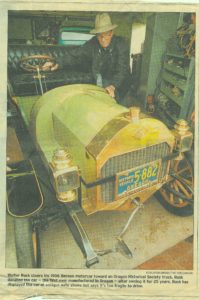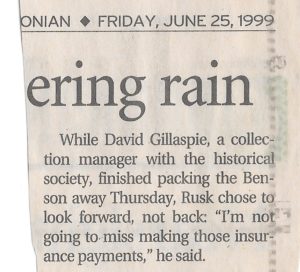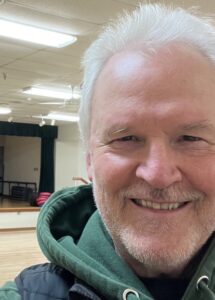Things don’t get much earlier when it’s called The First of anything, like the first car built in Portland.
That’s it in the picture. Nice car. Getting it from the donor to the museum was the job.
My job. Listening to an older man cuss about everything was part of the job.
Ask a simple yes or no question and I got, “For C****’* f****** sake I’m supposed to answer a dumba** question from some c*******er who shows up here knowing g**damn good and f***** well the answer before asking some dumbsh!t question like that?”
Sound fun so far? The question: “Could you spell your name for me?”
The weird part about it all was the way he made it all sound normal. Every added syllable of profanity sounded funnier than the last. It was almost like the old guy had something to prove with cussing.
What did he prove? That he had a lot to say, that he had a good vocabulary he kept hidden, that he wanted us men to know we were in a man’s presence.
I used the same manly angle when I met guys who looked like a Man’s Man. While talking to a new acquaintance I broke out my cussing hand book and sprinkled the salty talk until he stopped me.
“David,” he said, “you do know I’m an ordained minister?”
The next words out of my mouth were,”I’m sorry. No I didn’t.”
I’ve been careful with my cussing ever since.
Sometimes it works, sometimes not. It worked well with the man and his car.
Portland was set to be a iron manufacturing base and the car above was proof it might work in the right situation.
From Oregon Encyclopedia:
The founders of the Oregon Iron Company—led by William S. Ladd, John Green, and Henry Green—sought to capitalize on iron deposits in the hills around Sucker Lake (now Oswego Lake). Controlling the means of iron production was part of their vision for a commercial empire in the Pacific Northwest. Most of Portland’s cast-iron architecture and the pipe for its water system were made of Oswego iron.
The Oswego Furnace was Oregon’s largest manufacturing enterprise in the nineteenth century. It consumed ore from two mines and charcoal from 22,000 acres of timber. Over the course of its operation, three companies owned the works: Oregon Iron Company, Oswego Iron Company, and Oregon Iron & Steel Company.
It was the wrong time to create another Detroit in Oregon, but one car made it out.
From autotour.com:
The Benson automobile ended up being stored in a shed behind Benson’s home on NE 92nd Place. It was sold to neighbor William McAllister in 1951 and then to Walter Rusk in 1973. Rusk restored to automobile in 1973-74 and donated it to the Oregon Historical Society in 1999. Today, the Benson automobile is on display at the Oregon Historical Society’s Museum in Portland.
Mr. Rusk met me at a storage building in Gresham. The driveway was a narrow one lane road with brush and branches scraping my truck. An Oregonian photographer met me there. I enlisted him to help load the car.
Back in the late 90’s the car got nearly a full page of coverage. Me? Not so much. But the cussing stayed with me. Why all the profanity? Then it struck me.
Older guys are vulnerable in a way they’ve never felt before. They need to project what strength they still have. If they do get into a scrape, they’ll be able to talk their way out. Except with cussing and all, a scrape may never happen. That’s the power of words.
Now that I’m closer to Mr. Rusk’s age, it all makes sense. I’d say it like this when I get just a little older:
“I f****** go all out and break my b**** loading and securing this m*****f***** for all of history and big a** thanks is a one f****** line mention in a sh*t rag? That’s f****** b***s***.”
If maturity is measured by choice, I choose nice every day of the f****** week. In a nice way.




